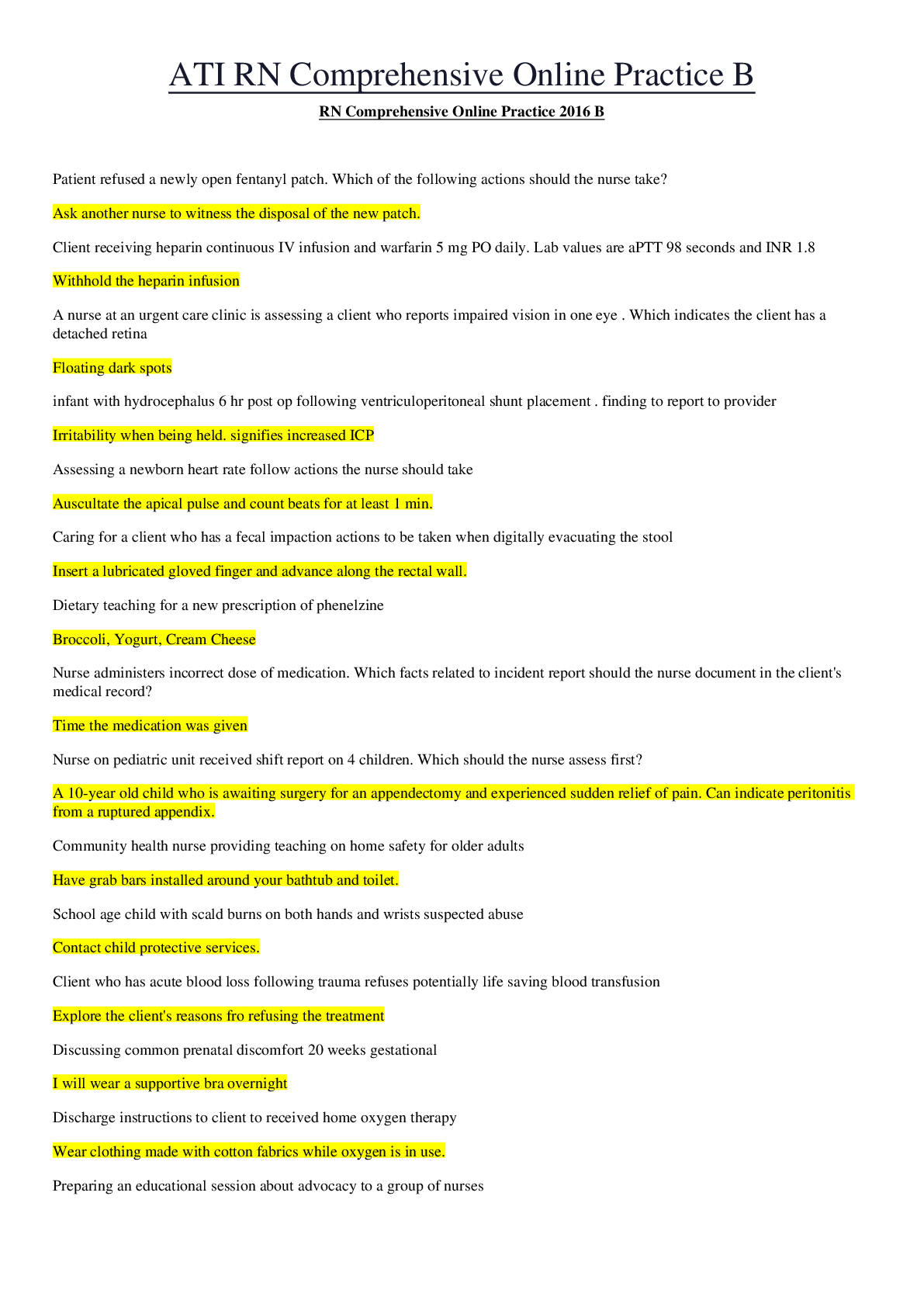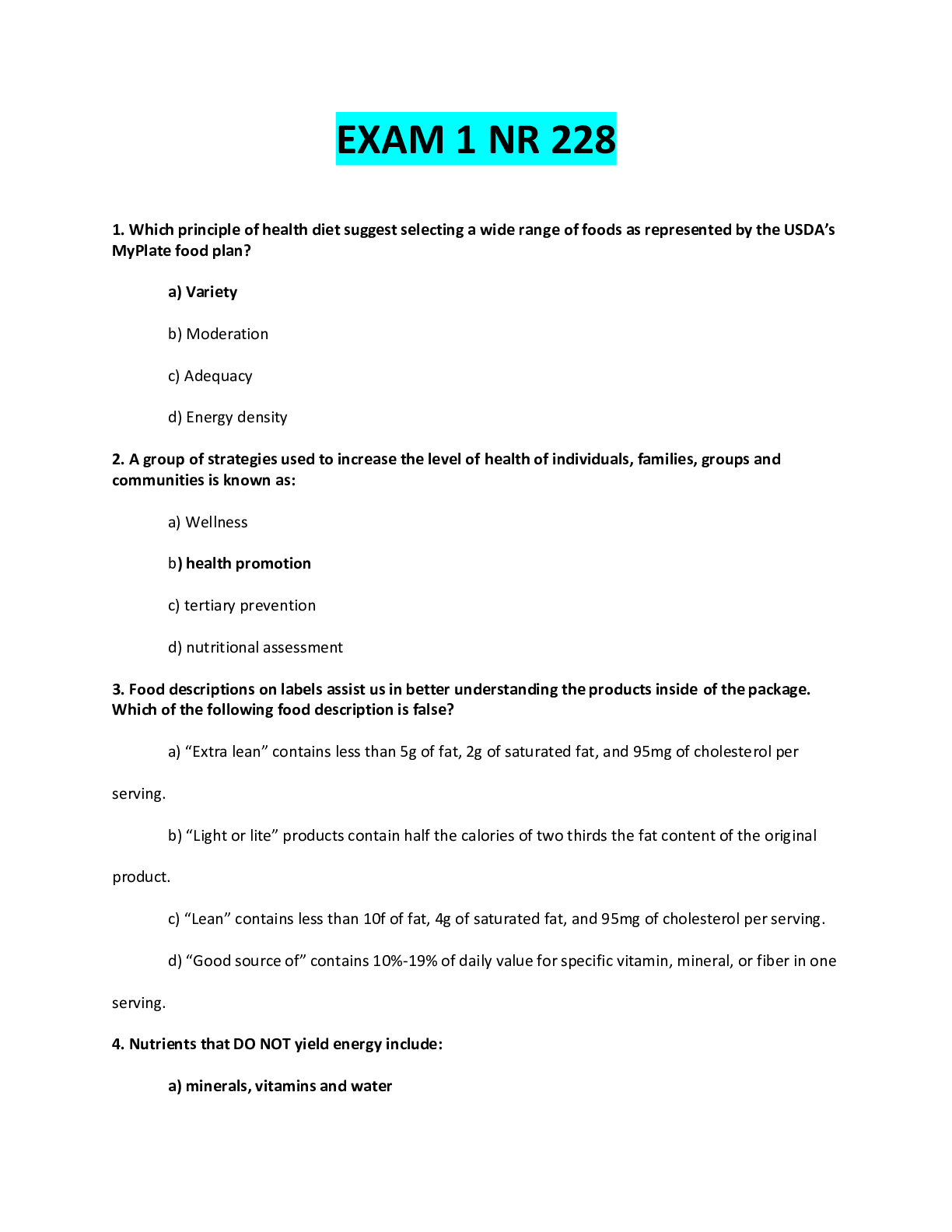*NURSING > EXAM > NR 351 Week 1 exam with answers - Wagner College (A grade) | NR351 Week 1 exam with answers - A grad (All)
NR 351 Week 1 exam with answers - Wagner College (A grade) | NR351 Week 1 exam with answers - A grade
Document Content and Description Below
NR 351 Week 1 exam with answers - Wagner College (A grade) NR 351 EXAM 1 Chapter 8 IOM (Institute of Medicine) six outcomes for new healthcare - Safe - Effective - Efficient - Patient-cen... tered - Timely - Equitable 1999- To ERR is Human – states that too many mistakes were made that could have been prevented; focused on human safety Health Care should be: - Affordable - Accessible - Quality and safety Continuously Learning -through science, public reports and patient-clinician partnerships IOM’s 4-tiered strategy to prevent medical errors: 1. Establish a national focus to create research and protocols to enhance our knowledge on safety 2. Identify and learn from errors by developing a nationwide public reporting system 3. Raising performance standards and have them be overlooked by higher authorities in health care professionals 4. Implement safety systems to ensure safe practice Pay Per Performance -DSRIP (delivery system reform incentive payment program) Goal: to reduce hospital readmissions by 25% Gives incentive to hospitals by giving them a monetary rewards Fined if they can’t do it PPACA (patient protection and affordable care act) Goal: to decrease number of uninsured, control healthcare costs and improve healthcare delivery system Provide a new way to get health insurance: The Health Insurance Marketplace AHRQ- Agency for Health Care Research and Quality Levels of Health Care 1. Preventive- focuses on educating to prevent future health problems 2. Primary- treatment of common health problems a. Physicals once a year 3. Secondary- treatment of problems requiring more specialized clinical experience a. More than routine ex/diabetes 4. Tertiary- management of rare and complex disorders a. Chronic illnesses/no cure U.S. is a multipayer system: -Government funded (Medicaid = poor / Medicare = old) -Military = champus/tricare -Private plans 1. Traditional insurances 2. MCOs- Managed care organizations- quality care designed to control costs 3. PPOs- Preferred provider organizations- clients choose from a list of providers 4. EPOs- Exclusive provider organizations- clients choose from a list of providers within a contracted organization 5. Long term insurance DRGs – diagnosis related grouping -When you go into the hospital it refers to the length of stay they believe you should have according to what it wrong with you or what procedure you are getting done. Discharge planning- starts as soon as you are admitted Health Care Settings 1. Primary Care Centers a. APRN’s, NP’s, midwives and clinical nurse specialists work with physicians to help patients 2. Home Health Care a. Rapidly growing- based out of hospitals or private home care agency b. Helps support patient and their families 3. Extended Care Facilities a. Assisted living/ transitional sub acute care/ intermediate and long term care b. “Aging in place” 4. Specialized Care Centers and Settings a. Daycare/ mental health/ schools/ rehab centers/ homeless centers b. Focus on restorative health for follow-up care 5. Health care Services for the Seriously Ill and Dying a. Respite care- family care that needs a break/ beds in hospital for patient b. Hospice care- dignity and comfort for those dying c. Palliative care- focuses on emotional, physical and spiritual distress To be part of the healthcare team you NEED to be a team player! Trends in healthcare/nursing: -Increased diversity and technology -Educated and engaged consumers -Costs of healthcare -Shortages of healthcare professionals -EBP -Culturally competent for diverse populations -Decreased length of hospital stay -Aging population Strategies to reduce healthcare costs - DRGs - Bundled payments and better rates - Eliminating fraud/abuse - Improving population health - More efficient and less costly Currently, healthcare is a privilege and we are trying to make it a moral right. But, risk takers aren’t wanted. (ex/ drugatics who we save and diabetics who wont eat right) Chapter 1 History of Nursing -Early civilization- nurse was mother/ temples were the place for care -Early Christian period- socialites and nuns were nurses -16th century- expansion of knowledge occurred/nurses were needed more - - - - - - - - - - - - - - - - - - - - - - - - - - - - - - - - - - - - Legal Safeguards for Nurses -competent practice/adequate staffing -informed consent or refusal- this is a process- need signature -Documentation- key to a competent practice -Whistle-blowing- nurses who speak up -Professional liability insurance- how much it could cover you in case of an incident -Risk management programs -Incident reports- used for quality improvement -Sentinel events- unexpected occurrences such as death or serious injury -Never events- list of 29 events- VERY serious ex/wrong patient, wrong part -Patient’s rights/good Samaritan laws Elements of Informed Consent 1. Disclosure- patient has to be aware 2. Comprehension- understand that it is not a guaranteed outcome 3. Competence-make sure they understand 4. Voluntariness- make sure they are willing Risk Management Programs-designed to identify/analyze issues and treat risks -safety program- environment safety -products safety program- safe-adequate equipment -quality assurance programs- quality healthcare to patients; ongoing evaluation of patient care Incident Reports -complete name, characteristics, date and time of incident -factual evidence -documentation by physician OSHA- Occupational Safety and Health Regulations: -use of electrical equipment -use of isolation techniques -use of radiation/chemicals HIPAA-Ensured Patients Rights -to see, copy and update their health record -to get a list of disclosures and request correction of any mistakes -to choose how to receive health information Chapter 6 Value Transmission -modeling, moralizing, laissez-faire, rewarding and punishing, responsible choice 1. Choosing- choosing freely from alternatives after careful consideration of the consequences of other alternatives 2. Prizing (treasuring)- involves pride, happiness and public affirmation 3. Acting-combining choice into one’s behavior with consistency and regularity on the value Altruism- concern for welfare and well-being of others Autonomy- right to self-determination Human dignity- respect for inherent worth and uniqueness of individuals and populations Integrity- acting according to code of ethics and standards of practice Social justice- upholding moral, legal and humanistic rights Types of Ethics 1. Bioethics- encompasses a number of fields of “life sciences” 2. Nursing ethics- formal study of ethical issues that arise in nursing 3. Feminist ethics- critiques existing patterns of oppression and domination in society effecting women Utilitarian- the rightness or wrongness of an action depends on the consequences of the action Deontologic- an action is right or wrong independent of its consequences Beauchamp and Childress’s -Autonomy- respect rights of patients to make healthcare decisions -Nonmaleficence- avoid causing harm -Beneficence- benefit the patient -Justice- give each his or her due and act fairly -Fidelity- keep promises TRUST Functions of Ethics Committees 1. Education 2. Policy making 3. Case review 4. Consultation -occasionally research [Show More]
Last updated: 2 years ago
Preview 1 out of 19 pages
.png)
Buy this document to get the full access instantly
Instant Download Access after purchase
Buy NowInstant download
We Accept:

Reviews( 0 )
$12.50
Can't find what you want? Try our AI powered Search
Document information
Connected school, study & course
About the document
Uploaded On
Jan 18, 2021
Number of pages
19
Written in
Additional information
This document has been written for:
Uploaded
Jan 18, 2021
Downloads
0
Views
108
.png)








 – University of the People.png)















.png)

